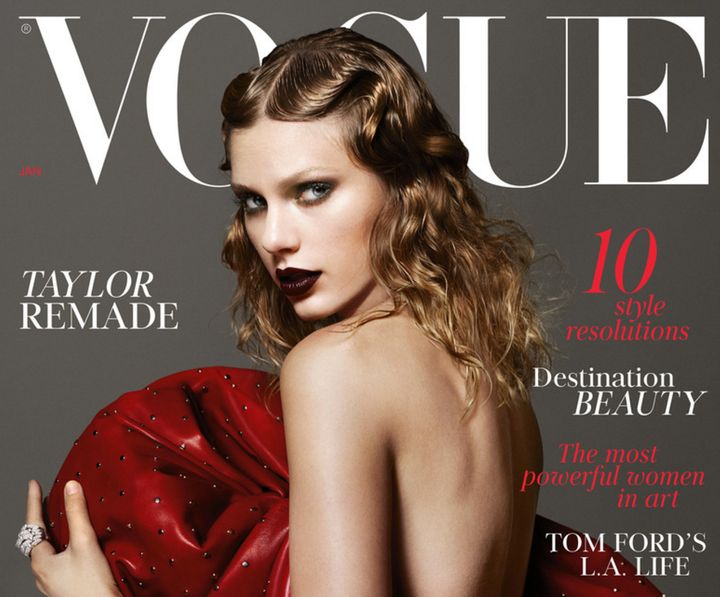
After the thrill of seeing a new dawn unfold before my eyes as British Vogue’s first cover under Edward Enninful was revealed, I’m afraid I’m rather disappointed with their second offering: a ‘re-invented’ Taylor Swift as the cover girl.
I’m not an avid reader of Vogue, but with the magazine’s re-birth featuring model and activist Adwaoh Aboah, I was considering a subscription. I was proud that HuffPost UK was among the first media sites to break the news. Not even Alexandra Shulman’s dodgy Guardian interview could phase me, not because it wasn’t grating, but because I was on a cultural high.
Let’s forget, for a sec, that Swift has had multiple run-ins with controversy - from that whole Kim KW debacle to ‘snake’ gate. My issue isn’t so much with her being on the cover of a (British?) Vogue, just with Enninful having her on the cover of this British Vogue, the second of his supposedly groundbreaking new tenure. In my opinion, it was too soon to bring back the staple, Shulman-esque way of doing things.
Let’s instead focus on the #NewVogue, a publication that boasted an impressive roster of British movers and shakers, from famed essayist Zadie Smith to Sadiq Khan, the first Muslim Mayor of London. Of the contributors to the first issue under his title, Enninful practically bragged about their diverse backgrounds, saying: “I hope you will be as gratified as I am to note how many of the amazing names featured on these pages didn’t necessarily begin their lives here… Regardless of where they were born or how they got here, however, they all share huge pride in their homeland, with an outlook that is pleasingly global.” So, the hashtag new Vogue’s M.O would be very British but very diverse - right? Nope.
The first issue was called the British issue, where creative Britons were celebrated in all their diverse, talented glory. It might have escaped the notice of some that this theme was for one issue only, not the entire new direction for British Vogue going forward. Fair enough. Yet I still think featuring a British cover star would have been a stronger, more uniting option. Not least because we have so many to choose from - from Jourdan Dunn to Daphne Guinness, Grayson Perry and Erin O’Connor. Style icons one and all in their own quirky, British quintessentialism.
“Be sure of this” said Enninful in his editor’s letter from the Aboah issue. “My Vogue will be the fashion bible.” While I trust this to be true, given Enninful’s track record as a renowned stylist and director, the Swift cover does not quite live up to such a bold statement. The clothes used for the cover story are cute (when are they ever not? It’s Vogue, after all), but not groundbreaking fashion. Not even style is covered in the way Vogue is supposed to push the boundaries. So, fashion bible? Time will tell, but from this cover, not that. Moreover, Swift was supposedly transformed by the editor himself but, given her style evolution from country girl next door to bonafide Queen Bee of a fierce ’squad’ of highly successful women, there was not much of a metamorphosis. What no one seems to notice is that Swift’s style of late has been a little more out of the box than her country persona would have previously allowed - what remains precisely intact is the taut ‘good girl’ image she has presented herself as. So transformation? No to that, either.
Lastly, there were murmurings to the effect that Swift is yet another cis, slender, white and privileged person being celebrated in a world where her kin - for want of a better word - dominate. While I personally think this is a reach (we can’t, after all, blame the individual for the plight of the many, even if they epitomise the harmful standard of the ideal that ultimately oppresses others), I have to admit the lack of any other names on the cover is problematic. Okay, there’s Tom Ford - but see above. This deliberate absence of anything that might distract from the cover star is suspect, at best. The minimalist approach forces audiences to focus solely on the central point of the cover, which would be fine if it was felt that said person is deserving of such high attention. A great example of this was British GQ’s cover feature of the Duke of Cambridge on the 20th anniversary year of his mother’s passing.
Focusing on Swift in the same manner seems out of place and, when considering Aboah was only the third black (sorry, biracial) model to be featured alone on the cover of the prestigious magazine in over 100 years, prickly. One Vogue follower said it well on Instagram: “I see the ghost of Alexandra Shulman hasn’t quite left the building yet…”
I’ll admit, my disappointment of this Vogue cover makes little sense to even me. It’s not like I was a subscriber for life. I don’t even read Vogue. I gave it up, along with other glossies, when I was 13 and swore to the muses that I’d never leave the side of a decent novel ever again. I have (for the most part) managed to keep that promise. And who can blame me, when almost every new purchase of the idolised glossy is so unflinchingly contrived?
All I can say to Enninful and the team of #NewVogue: more of the first please.
